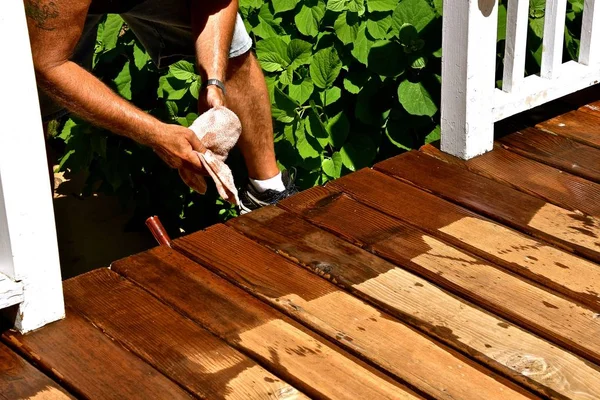The Ultimate Guide To Deck Sealing: Protecting Your Outdoor Oasis
A deck can be the crown jewel of your outdoor living space, providing a perfect spot for relaxation, entertainment, and enjoying the beauty of nature. However, exposure to the elements can take its toll on your deck, leading to wear and tear, fading, and even structural damage. This is where deck sealing comes into play. In this comprehensive guide, we'll explore everything you need to know about deck sealing to ensure that your outdoor oasis remains pristine and protected for years to come.
What is Deck Sealing?
Deck sealing is the process of applying a protective coating to your deck's surface to shield it from moisture, UV rays, mold, mildew, and other environmental factors. This helps to prevent damage, prolong the lifespan of your deck, and maintain its aesthetic appeal.
Why is Deck Sealing Important?
- Protection Against Moisture: Moisture is one of the biggest threats to wooden decks, causing rot, warping, and decay over time. A quality sealant forms a barrier that repels water, preventing it from seeping into the wood.
- UV Protection: Sunlight can fade and weaken the wood fibers in your deck, leading to discoloration and deterioration. Deck sealants contain UV inhibitors that shield the wood from harmful UV rays, preserving its natural color and integrity.
- Prevention of Mold and Mildew: Moisture and humidity create ideal conditions for mold and mildew growth, which can not only mar the appearance of your deck but also pose health risks. Sealing your deck helps to inhibit the growth of these unsightly and potentially harmful organisms.
- Enhanced Aesthetic Appeal: A well-sealed deck looks better and lasts longer. By maintaining the integrity of the wood and protecting it from environmental damage, sealing helps to keep your deck looking fresh and inviting.
Types of Deck Sealants

Oil-Based Sealants
Oil-based sealants penetrate deep into the wood, providing excellent protection against moisture and UV rays. They enhance the natural beauty of the wood by enriching its color and grain. However, they may require more frequent reapplication and can be prone to mildew growth.
Water-Based Sealants
Water-based sealants offer quick drying times and easy cleanup, making them convenient to use. They provide good protection against moisture and UV rays while maintaining the natural look of the wood. However, they may not penetrate as deeply as oil-based sealants and may require more frequent reapplication.
Acrylic Sealants
Acrylic sealants form a protective film on the surface of the wood, offering excellent moisture and UV protection. They are available in a variety of finishes, including clear, tinted, and semi-transparent, allowing you to customize the look of your deck. However, acrylic sealants may not penetrate as deeply as oil-based sealants and can be prone to peeling and flaking over time.
Hybrid Sealants
Hybrid sealants combine the benefits of oil-based and water-based formulas, offering deep penetration and long-lasting protection. They are easy to apply and clean up, making them a popular choice for DIY enthusiasts. Hybrid sealants provide superior moisture and UV protection while enhancing the natural beauty of the wood.
Preparation and Application

Preparing Your Deck
Before sealing your deck, it's essential to ensure that the surface is clean, dry, and free of debris. Start by sweeping away any dirt, leaves, and debris, then wash the deck thoroughly with a deck cleaner or mild detergent and water. Allow the deck to dry completely before proceeding to the next step.
Choosing the Right Time
The best time to seal your deck is during dry weather when temperatures are mild and there is no rain in the forecast. Avoid sealing your deck in extreme heat or direct sunlight, as this can cause the sealant to dry too quickly and not penetrate the wood properly.
Applying the Sealant
Wear protective clothing, gloves, and safety goggles to protect yourself from the sealant fumes and splashes. If using a liquid sealant, be sure to stir it thoroughly before application to ensure uniform consistency. Apply the sealant evenly using a brush, roller, or sprayer, working in small sections from one end of the deck to the other. Be sure to coat all surfaces, including the railings, stairs, and underside of the deck boards.
Depending on the type of sealant you're using, you may need to apply multiple coats for optimal protection. Allow each coat to dry completely before applying the next one. Clean up any spills or drips immediately with a rag or paper towel. Dispose of used applicators and rags properly according to the manufacturer's instructions.
Maintenance Tips
- Regular Inspections: Inspect your deck regularly for signs of wear and damage, such as cracks, splinters, or discoloration. Address any issues promptly to prevent them from worsening and compromising the integrity of your deck.
- Cleaning: Regularly sweep or hose off your deck to remove dirt, leaves, and debris that can trap moisture and promote mold and mildew growth. You can also use a mild detergent and water solution to clean stubborn stains and spots.
- Reapplication: Monitor the condition of your deck's sealant and reapply it as needed to maintain optimal protection. A good rule of thumb is to reseal your deck every 1-3 years, depending on the type of sealant used and the level of exposure to the elements.
- Repairing: Address any minor repairs, such as loose boards or protruding nails, as soon as you notice them to prevent safety hazards and further damage to your deck. Replace damaged boards or hardware as needed to ensure the structural integrity of your deck.
Hawthorn VIC, Australia
Phone: 1800-332-525

